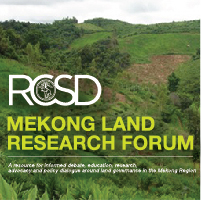Location
The purpose of the Mekong Land Research Forum online site is to provide structured access to published and unpublished research on land issues in the Mekong Region. It is based on the premise that debates and decisions around land governance can be enhanced by drawing on the considerable volume of research, documented experience and action-based reflection that is available. The online site seeks to organise the combined work of many researchers, practitioners and policy advocates around key themes relevant to the land security, and hence well-being, of smallholders in Cambodia, Laos, Myanmar, Thailand and Vietnam.
The research material on this site is mounted at three levels:
First, a selection of journal articles, reports and other materials is provided and organised thematically to assist researchers, practitioners and policy advocates to draw on one another’s work and hence build up a collective body of knowledge. This is the most “passive” presentation of the research material; our contribution is to find and select the most relevant material and to organise it into key themes. In some cases the entire article is available. In others, for copyright reasons, only an abstract or summary is available and users will need to access documents through the relevant journal or organisation.
Second, a sub-set of the articles has been annotated, with overall commentary on the significance of the article and the research on which it is based, plus commentary relevant to each of the key themes addressed by the article.
Third, the findings and key messages of the annotated articles are synthesised into summaries of each of fourteen key themes. For each key theme, there is a one-page overall summary. Extended summaries are being developed progressively for each theme as part of the Forum's ongoing activity.
Overall, we intend that this online site will contribute toward evidence-based progressive policy reform in the key area of land governance. We further hope that it will thereby contribute toward to the well-being of the rural poor, ethnic minorities and women in particular, who face disadvantage in making a living as a result of insecure land tenure.
Members:
Resources
Displaying 426 - 430 of 564Scaling the landscapes: a methodology to support integrated subnational spatial planning in Cambodia
INTRODUCTION: Over the last 30 years, the context of development in Cambodian has undergone dramatic changes. A succession of deep transformations, characterized by a complete restructuring of institutional and socio-economic environment, has resulted in a singular situation. Cambodian society remains largely agrarian, with land being the corner stone of the production system for a large majority of the population.
Land Tenure: A foundation for food security in Myanmar's uplands
Access to land for smallholder farmers is a critical foundation for food security in Myanmar's uplands. Land tenure guarantees seem to be eroding and access to land becoming more difficult in some upland areas. If this trend continues it may have negative impacts for food security and undermine environmental and economic sustainability. This briefing paper explores the relationship between land tenure and food security, as well as key institutional and other factors that influence land access and tenure for smallholder farmers in the uplands today.
National Gender Profile of Agricultural Households 2010
Cambodia has a land area of 181 035 square kilometers and a population of almost 14 million people (2008). In 2008, about 82 percent of the households lived in rural areas. A large majority of these households engage in rice- based agriculture, collection of forest products and livestock production. The agricultural sector generates about 32 percent of the Gross Domestic Product and provides employment to about 80 percent of the country’s labour force. The sector is dominated by small farm households who are mainly engaged in subsistence production.
Rural women's access to land and property in selected countries: Progress towards achieving the aims of the Convention on the Elimination of all forms of Discrimination against Women (CEDAW) INCLUDING 2010 UPDATE
In 2010, the ILC Secretariat decided to update information contained in the 2004 publication, so as to have a new basis to work more closely with and through CEDAW at national level. The update gives more visibility to the CEDAW Committee’s Concluding Observations and, accordingly, also to the CSOs’ shadow reports feeding them. This inclusion offers a more critical and comprehensive, if preliminary, overview of the situation of rural women in selected countries. NOTE: The 2004 publication is also available through this site.
USAID Country Profile: Property Rights and Resource Governance - Burma
Burma is situated in Southeastern Asia, bordering Bangladesh, India, China, Laos and Thailand. The majority of its population lives in rural areas and depends on land as a primary means of livelihood. Because all land in Burma ultimately belongs to the state, citizens and organizations depend upon use-rights, but do not own land. Burma’s laws grant women equal rights in some respects and also recognize certain customary laws that provide women equal rights in relation to land.


